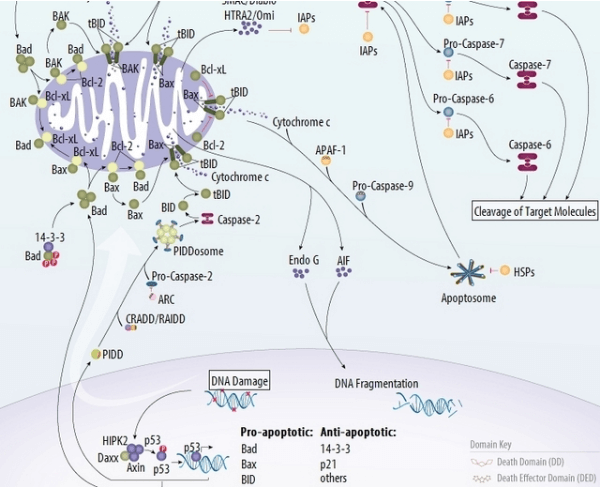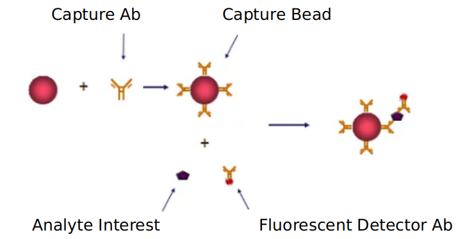Introduction to cell senescence signaling pathway
Based on Luminex technology platform, Creative Proteomics provides analysis services for key targets of cell senescence signaling pathway.
 Cell Senescence is a natural aspect of life. Understanding the various mechanisms that cause the progressive decline of cellular and tissue function may aid in developing therapies to delay or treat age-related conditions and diseases. A variety of stressors, including strong mitogenic signals, DNA damage, and non-genotoxic chromatin perturbations cause cellular senescence - a state of permanent cell cycle arrest. Cellular senescence, although useful in young organisms to prevent cancer, is thought to promote aging. The most consistent determinant of life-span in eukaryotes is the mitogenic growth hormone/IGF-I pathway. However, premature aging syndromes caused by defects in the cellular response/repair to DNA damage indicate the role of accumulated damage. The complex biology of aging is impacted by both environmental and genetic factors: stochastic DNA damage causes decline of function, and genetics determines the rates of damage accumulation and functional decline.
Cell Senescence is a natural aspect of life. Understanding the various mechanisms that cause the progressive decline of cellular and tissue function may aid in developing therapies to delay or treat age-related conditions and diseases. A variety of stressors, including strong mitogenic signals, DNA damage, and non-genotoxic chromatin perturbations cause cellular senescence - a state of permanent cell cycle arrest. Cellular senescence, although useful in young organisms to prevent cancer, is thought to promote aging. The most consistent determinant of life-span in eukaryotes is the mitogenic growth hormone/IGF-I pathway. However, premature aging syndromes caused by defects in the cellular response/repair to DNA damage indicate the role of accumulated damage. The complex biology of aging is impacted by both environmental and genetic factors: stochastic DNA damage causes decline of function, and genetics determines the rates of damage accumulation and functional decline.
One of the main characteristics of cellular senescence is that the cell permanently exits the cell cycle. Therefore, many cell cycle-related proteins play an important role in the process of cell aging and can be used as markers of cell aging.
Aging is a physiological phenomenon that spontaneously grows with age, manifested as degenerative diseases of the body structure, atrophy of organs, and functional decline. The decline of cell proliferation caused by cell senescence is one of the root causes of organ aging, atrophy, and functional decline. Therefore, cellular senescence is closely related to the aging of the body and the occurrence of senile diseases. The occurrence and development of cell senescence is a comprehensive result of multi-factor participation and coordinated regulation of a series of genes. In recent years, multiple signaling pathways related to cell senescence have been discovered, including the classic p53/pRB, insulin/IGF-1, mTOR, AMPK, Cell Senescence and other signaling pathways. These signal pathways are interconnected and influence each other, thus forming a complex cellular senescence regulatory network.
The cellular senescence pathway is mainly manifested by cell proliferation arrest, the accumulation of senescence-associated β-galactosidase (SA-β-GAL) 1, the appearance of senescence-associated secretory phenotype (SASP), and the cyclin-dependent kinase inhibitor (CKI) )expression. Cell senescence is triggered by a large number of extracellular and intracellular elicitors, which are pathologically or physiologically involved in age-related diseases, tumor suppression and tissue morphology. The aging process is coordinated through a variety of regulatory networks guided by endogenous and exogenous senescence-inducing signals.
Our detectable targets:
| BAD | BAX | PIP2 | IP3 | STAT2 | STAT3 |
| tBID | Bcl-2 | JNK | MYD88 | Rac1 | TLR4 |
| Bcl-xl | APAF-1 | MAPK | NAP1 | Rel | TLR9 |
| PIDD | icam1 | Mda-5 | NFκB | RIG-1 | TRAF3 |
| AIF | IRF9 | MEKK1 | p38 | RIP1 | TRAF5 |
| IAPs | IRF5 | MEK3 | p38MAPK | SH2 | TRAF6 |
| MHC-II | IRS1 | MEK6 | p50 | SLP76 | TRAM |
| PSGL1 | IRS2 | MSK1 | TLR3 | Tak1 | TRIF |
| IKB | ISGF3 | MSK2 | PI3K | TBK1 | Vav |
| PMCA | ISRE | mTOR | PKR |
Technology platform
We provide Luminex technology for cell senescence signaling pathway analysis.
Luminex technology is a multifunctional liquid phase analysis platform developed on the basis of colored microspheres, laser technology, applied fluidics and high-speed digital signal processing technology. The core is to encode polypropylene microspheres or magnetic microspheres with fluorescent dyes. By adjusting the different ratios of the two fluorescent dyes, up to 100 microspheres with different fluorescence spectra can be obtained. Antigen-antibody, enzyme-substrate, ligand-receptor binding reactions and nucleic acid hybridization reactions are performed on microspheres with different fluorescence encoding. Qualitative and quantitative analysis by laser detection of microsphere coding and reporter fluorescence separately.
Cell senescence signaling pathways play an important role in cell proliferation, organ aging, atrophy, functional decline, disease, tumor suppression, and tissue morphology.
In addition to Luminex Multiplex Assay, Enzyme-linked immunosorbent assay (ELISA), Flow cytometry (FACS analysis) technology can also be provided to meet other customer needs.
Advantages of cell senescence signaling pathway detection:
- High-throughput: Simultaneous analysis of multiple target molecules in the same sample. Theoretically, the detection flux is equal to the number of types of microspheres, that is, up to 100 types.
- Low sample consumption: Because 100 different target molecules can be detected in the same reaction well at the same time, the amount of sample is greatly saved; and because of the small size of the microspheres, as little as 1 puL of samples can be detected.
- Simple and fast operation: Because it is a liquid phase system, the reaction time is greatly shortened, and multiple cytokine detection can be completed within 2 to 3 hours.

Application of our service:
- To study the regulation mechanism of cell senescence signal pathway in disease
- To study the effect of each virus on cell senescence signaling pathway
- To study the effects of drugs or therapies on cell senescence signaling pathways
Creative Proteomics has developed a signal pathway target detection platform. We are not limited to providing cell senescence signal path detection services, but can also provide other signal path detection services. If you want to detect other targets, please contact us and we will customize the service for you. Look forward to working with you.
References:
- Sarantis Gagos, Dimitris Iliopoulos, et al. Cell senescence and a mechanism of clonal evolution leading to continuous cell proliferation, loss of heterozygosity, and tumor heterogeneity: Studies on two immortal colon cancer cell lines. Cancer Genetics and Cytogenetics, 2019, 90(2): 157-165.
- PanayotisKarayannakos, GregorySkalkeas, et al. Irreversibility of cellular senescence: dual roles of p16INK4a/Rb-pathway in cell cycle control.Akiko Takahashi. Naoko Ohtani & Eiji Hara, 2018.



